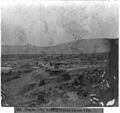Empire and the Carson River mills facts for kids
Quick facts for kids Empire and the Carson River mills |
|
|---|---|
| Lua error in Module:Location_map at line 420: attempt to index field 'wikibase' (a nil value). | |
| Built | 1860 |
| Reference no. | 1 |
Empire and Carson River mills is a historic area in Carson City, Nevada. This place was once very important for processing valuable metals. It was located along the Carson River, near a town called Empire. This Empire is now part of Carson City.
Contents
A Look Back in Time
In the 1850s, a man named Nicholas Ambrose set up a station. It was along the Carson River. People knew it as Dutch Nicks Station or just Nicks Station. Later, in May 1860, Eugene Angel and others planned a town there. They named it Empire City.
The Busy Mills
The first mill built here was called "The Mexican." It started in 1860. Its job was to process ore from the famous Comstock Lode. Ore is rock that contains valuable metals like silver or gold. Some people believe there were as many as 186 mills working in the area. They had interesting names like "Brunswick," "Merrimac," "Santiago," "Vivian," and "Yellow Jacket."
Mark Twain's Funny Story
On October 23, 1863, the famous writer Mark Twain wrote a funny, fake news story. It was called "A Bloody Massacre near Carson." Sometimes it's called the "Empire City Massacre Hoax." The story was about a man who supposedly killed his wife and nine children.
Twain wrote that the man lived in a "great pine forest" between Empire City and Dutch Nick's. But here's the funny part: there was no pine forest within 15 miles of Empire City at that time! Also, Empire City and Dutch Nick's were actually the same place. It was all a big joke!
This historic area is recognized as Nevada Historical Marker number 1.
Important People from Empire
- Anne Henrietta Martin: She was a leader who fought for women's right to vote. She also worked for peace and was an author.
- Edwin E. Roberts: He was a representative for Nevada in the U.S. government. He also served as the mayor of Reno.
Images for kids


